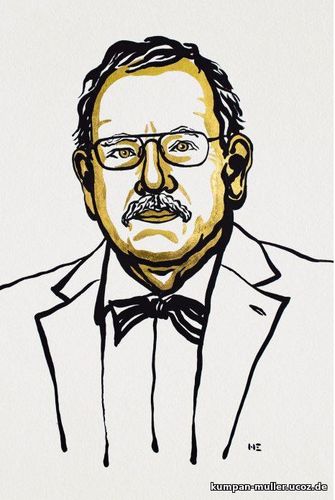Alexander Vasiljev-Muller Dr.econ(PhD)
Publisher
| Главная » Статьи » Scandinavia-Bavaria-Khust //Скандинавия-Бавария-Хуст /Мюллеры-Кумпаны-Валерий Васильев |
Reinhard Genzel Born: 24 March 1952, Bad Homburg vor der Höhe, Germany Affiliation at the time of the award: University of California, Berkeley, CA, USA, Max Planck Institute for Extraterrestrial Physics, Garching, Germany Genzel, a Berkeley professor emeritus of physics and astronomy, as well as director of the Max Planck Institute for Extraterrestrial Physics in Germany, credited the late Berkeley Nobel laureate Charles Townes for initiating the studies that led to the discovery. Decades ago, Townes, the inventor of the maser and laser, desperately wanted to use infrared detectors to study the center of the galaxy, which some astronomers thought might host an unseen and very large black hole. Prize motivation: "for the discovery of a supermassive compact object at the centre of our galaxy." We Congratulate the Outstanding German Physicist Reinhard Genzel with a well-deserved AWARD! We want to note that its discovery for the members of the Academy was expected, because our colleague Yuri Belousov in 2003 at an international scientific-practical conference in Mariupol introduced us to his discovery, which made it possible to prove the existence of a black hole in the solar system by calculation (it is a pity that he did not fulfill his calculations for our galaxy; would probably come out to justify the existence of a Big Black Hole). This discovery was heard by four members of the New York Academy of Sciences, who petitioned the International Biographical Center in Cambridge to recognize the merits of Yuri Belousov. The management of the (IBC) Center highly appreciated the work of our colleague and together with us he was sincerely grateful to his colleagues in London. Presidium of the Azov Department of the ES&E Academy
Мы хотим отметить, что его открытие для членов Академии было ожидаемо, потому что наш коллега Юрий Белоусов в 2003 году на международной научно-практической конференции в Мариуполе познакомил нас со своим открытие, которое давало возможность расчётным путем доказать существование черной дыры в солнечной системе (жаль, что он не выполнил свои расчёты для нашей галактики; вероятно, вышел бы на обоснование существование Большой черной дыры). Это его открытие слушало четыре члена Нью-Йоркской Академии наук, которые ходатайствовали перед Международным Биографическим Центром в Кембридже о признании заслуг Юрия Белоусова. Руководство Центра высоко отметило работу нашего коллеги и он вместе с нами был искренне благодарен коллегам в Лондоне. * * * “I was very pleased that I got mails from all four of Townes’ daughters,” he said. “That is very important to me, because they appreciate where it all comes from. Berkeley has played a big role in this.” “You worked with our late, great Charlie Townes, also a Nobel laureate. I cannot imagine a more profound academic lineage than that, and I thank you for passing along your knowledge to generations of students and collaborators here at Berkeley,” Chancellor Carol Christ said to Genzel, in her welcoming remarks. Genzel’s research group, working with an adaptive optics system to sharpen images from the Very Large Telescope array in Chile, and Ghez’s group, using equivalent adaptive optics with the Keck I and II telescopes in Hawaii, ran neck and neck for decades, each spurring the other to greater precision and, eventually, to certainty that the heavy object at the galactic center could be nothing other than a supermassive black hole, some 4 million times more massive than our sun. “I very much appreciated the competition,” Genzel said. “It was like we were both artists, … and the scientific audience was in a perfect position to see us perform the same exercise and then judge whether the outcome was the same. And so, when the two teams would agree, the audience would believe what we have. It was initially very much of an advantage.” * * * «Мне было очень приятно, что я получил письма от всех четырех дочерей Таунса», - сказал он. «Это очень важно для меня, потому что они понимают, откуда все это исходит. Беркли сыграл в этом большую роль ». «Вы работали с нашим покойным великим Чарли Таунсом, также лауреатом Нобелевской премии. Я не могу представить себе более глубокую академическую линию, чем это, и я благодарю вас за передачу ваших знаний поколениям студентов и сотрудников здесь, в Беркли », - сказала канцлер Кэрол Крист Гензел в своем приветственном слове. Исследовательская группа Гензеля, работающая с системой адаптивной оптики для повышения резкости изображений с массива очень большого телескопа в Чили, и группа Геза, использующая эквивалентную адаптивную оптику с телескопами Keck I и II на Гавайях, десятилетиями работала нога в ногу, каждая из которых подталкивала другое - с большей точностью и, в конечном итоге, с уверенностью в том, что тяжелый объект в центре Галактики может быть не чем иным, как сверхмассивной черной дырой, примерно в 4 миллиона раз массивнее нашего Солнца. «Я очень оценил соревнование, - сказал Гензель. «Как будто мы оба были художниками… и научная аудитория была в идеальном положении, чтобы увидеть, как мы выполняем одно и то же упражнение, а затем оценить, был ли результат одинаковым. Итак, когда две команды согласятся, публика поверит тому, что у нас есть. Изначально это было большим преимуществом ». Команда Геза также приветствовала соревнование, сказала Джессика Лу, доцент астрономии Калифорнийского университета в Беркли, которая была частью команды Геза, изучающей галактический центр с тех пор, как она была аспирантом Калифорнийского университета в Лос-Анджелесе в 2003 году. «Этот дух соревнования действительно помог нам всем стать лучше», - сказала она. Источник: http://www.cic-wsc.org | |
Категория: Scandinavia-Bavaria-Khust //Скандинавия-Бавария-Хуст /Мюллеры-Кумпаны-Валерий Васильев | Добавил: Vasiljev (2020-10-07)
| Автор: A.Vasiljev, P.Poddubnyj  
| |
| Просмотров: 1140 | Теги: | Рейтинг: 5.0/1 | |
| Всего комментариев: 0 | |
Форма входа |
|---|
Категории раздела | |||||||
|---|---|---|---|---|---|---|---|
|
Поиск |
|---|
Наш опрос |
|---|
Статистика |
|---|
Онлайн всего: 1 Гостей: 1 Пользователей: 0 |
Друзья сайта |
|---|
|
|

